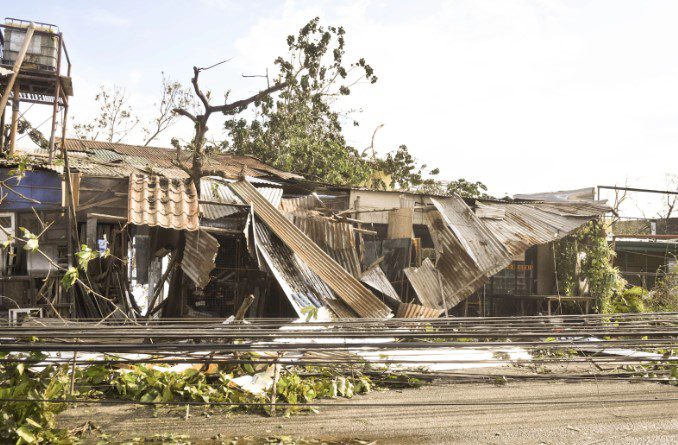Due to its location in the Pacific typhoon belt, the Philippines finds itself enduring the harsh effects of an average of 20 typhoons per year. Many of these typhoons tell stories that are etched into the nation’s – and each citizen’s – history.
Still, amidst the worst of times, Filipino resilience and bayanihan shine through. One important component of riding out these storms is media coverage. From live TV and radio reports to modern-day real-time updates via online platforms, media coverage remains vital. Delivering timely news about area-specific situations, typhoon progression, and more have often spelled the difference between life and death.
So let us peel back the layers of those experiences, explore the hard lessons learned, and recognize the critical role of media during these trying times:
How traditional media and reporting helped
- Typhoon Mike (Ruping) – November 1990
Back in November 1990, Ruping hit Visayas and Mindanao the hardest. It affected hundreds of thousands of homes and sunk around 77 vessels. This earned it the title of the most destructive – and expensive – cyclone (at that time!)
Cebu also found itself without power, water, or communication. These resources could have bridged rescue and relief efforts for its residents. This exposed just how unprepared the country was for a disaster of its magnitude, which former Senator John Osmena likened to “an atomic bomb”.
Following this catastrophe, PAGASA (Philippine Atmospheric, Geophysical and Astronomical Services Administration) decided to introduce the warning signal “No. 4”, which they deemed was far more suited to the scale of the devastation. They subsequently communicated this warning signal to the masses via the media, and people have heeded that warning since.
- Typhoon Thelma (Uring) – November 1991
A year after Ruping, Uring came barreling in, dealing its worst blows to the Visayas Region, particularly Ormoc City.
It was a heavy downpour that caused flash floods hat tore through neighborhoods, disrupting power lines, uprooting houses, and claiming an estimated 5,000 lives. It was considered one of the deadliest typhoons of its time.
Based on media reports, the rains had overwhelmed the Ormoc watershed’s ability to hold that much water. The unstable soil and torrential rains caused landslides that hit many people living in low-lying areas. According to experts, real-time alerts and monitoring in high-risk areas would have saved many from the impending disaster. The aftermath of this typhoon prompted more urgent attention to bolstering real-time media coverage for the benefit of the people.
- Typhoon Fengshen (Frank) – June 2008
Even before Typhoon Fengshen made landfall in June 2008, NASA’s Earth System Observatory was already on the case, using MODIS (Moderate Resolution Imaging Spectroradiometer) linked to their Terra satellite, which enabled them to keep tabs on the transition into a full-fledged storm. This provided real-time imaging that supplemented local forecasts’ reports. The public, especially those in Western and Central Visayas that lived near danger zones (e.g., mountain slopes, and large bodies of water), was notified in advance to help them evacuate. Travel via air and sea was also suspended.
However, one ferry was given the green light to travel: the MV Princess of the Stars. Despite warnings, the ship was believed to be adequately built enough to endure Fengshen’s impact. Unfortunately, this miscalculation led to the tragic capsize of the ferry that claimed 833 lives, with 58 survivors found near Sibuyan Island. Media coverage helped shine a spotlight on this incident, prompting stricter regulations around sea travel during storms.
The utilization of digital media for
- Typhoon Ketsana (Ondoy) – September 2009
Ondoy was projected to be a Signal No. 1 storm. With that, people went about their lives. People were wholly unprepared for the typhoon’s progression, dropping nearly a month’s worth of rain in just a matter of hours in September 2009.
As the tides rose in Metro Manila, Rizal, Laguna, and Bulacan, people had to abandon their vehicles to seek refuge. This caused a gridlock that complicated the rescue efforts in some areas. Power distributor Meralco had to cut off electricity in high-risk areas to prevent any further damage. By the end of it, the total impact of the typhoon soared to 1.5 billion worth of damages.
Despite initial troubles, the overall response was swift. Rescue teams were quickly mobilized. This was also one of the first times social media played a role in the aftermath. Netizens used Facebook and then-Twitter to spread key information such as rescue hotlines, locations in need of assistance, and more. This collective effort made “Ondoy” and “NDCC” (National Disaster Coordinating Council) trend internationally, allowing more people to spread the call for aid.
Spotlight-worthy initiatives during this calamity were Rescue Info Hub Central’s online spreadsheet that collected information on those needing rescue or assistance, and GMA News’ “Missing Persons Database” form.
The media also promptly reported Ondoy’s aftereffects. Reports on how badly congested the drainage system had become to cause such a water build-up initiated citizens to call on their LGUs and impose a ban against single-use plastic to help reduce the waste that caused drainage clogging.
- Typhoon Megi (Juan) – October 2010
Typhoon Megi (not to be confused with Megi 2022), was known locally as Juan: the supertyphoon with brutal winds of 225 km/h and intense rain that struck northern Luzon in October 2010. It caused so much damage to infrastructure and agriculture that it raised food security concerns and economic losses.
There were early warnings issued for Bagyong Juan that prompted measures to enforce evacuations and travel suspensions, with emergency supplies already waiting in the wings as people braced for its impact.
Unfortunately, there was one issue: the typhoon’s strength still toppled telecommunication and power grids, causing it to cease operations in a time when everyone is relying on it for contact and information.
This pushed many individuals to resort to Facebook and Twitter for real-time updates from PAGASA, news sites, and from their respective LGUs. This phenomenon solidified the importance of digital media to spread timely information, and spotlighted the use of hashtags for making emergency situations ‘trend’ for faster assistance.
- Typhoon Bopha (Pablo) – December 2012
Bagyong Pablo dampened holiday spirits when it tore through the southern island of Mindanao in December 2012, with maximum winds of 175 km/h that culminated in flash floods and landslides that buried everything in its path. Casualties soared in the thousands, and affected the lives of around 5.4 million people.
At this point, despite the media disseminating warnings issued by government agencies, some residents still underestimated the seriousness of evacuation alerts since the area rarely faced such intensity that they felt assured it would just be another downpour. However, Pablo destroyed farms, mines, homes, plantations, and even coral reefs enough that it was touted one of the strongest tropical cyclones the region experienced.
This prompted citizens to turn to social media to share their stories to serve as a warning to others to heed warnings issued by credible media. Said media, meanwhile, was starting to truly maximize their digital presence. Traditional media channels provided online broadcasts and coverage, such as Rappler’s “#WeatherAlert” 24/7. GMA News’ “YouScoop” also began to encourage netizens to submit their own footage of the calamities to get a better pulse of the occurences in local areas.
- Typhoon Haiyan (Yolanda) – November 2013
In 2013, Yolanda battered Tacloban so much that it would take almost a decade to fully recover from the damage.
The typhoon brought rains and winds topping 315 km/h (195mph), and a storm surge that practically submerged part of the small province.
More than ever, the media played an incredibly important role to assist rescue and aid efforts.
An international non-profit network called “First Response Radio” swooped in to help, broadcasting 8-hour daily programs that informed listeners about aid efforts, evacuation centers, and water supply spots.
Online, the hashtags “ReliefPH”, “AidMonitor”, and “Yolanda” eventually caught the eyes of international celebrities who helped in amplifying calls for donations. Volunteers used those tweets for real-time data input based on categories (e.g., request, image, or video) to help direct aid where it was most needed and improve the Yolanda relief map – an independent project – for easy navigation.
Among the many important discussions Yolanda’s aftermath opened was the use of local language. Despite warnings of a “storm surge”, many locals were unaware of the term. This prompted talks around the importance of local, layman language used in times of emergencies. Because of the unfamiliar warning, residents may have only anticipated heavy rainfall (typical to their region around that time of the year), and not tsunami-sized waves capable of wiping out an entire community. Many locals also insisted that, had the messaging been simpler, countless lives would have been spared.
This realization propelled PAGASA into developing a color-coded system that disseminated findings for better public grasp, as listed below:
- Green – No Alert
- Yellow – Be Alert
- Orange – Alarm
- Red – Take Action (e.g., evacuate)
Typhoon media coverage in 2024
With the culmination of years worth of typhoons, the country and its media continue to learn and do its best.
2024 saw around 7 typhoons hit the country. During many of these calamities, media outlets continue to provide better real-time coverage. News anchors brave literal storms, and news outlets continue to encourage regular citizens to contribute to local news reporting to provide a different perspective.
Social media also continues to play an important role. Netizens have taken to posting calls for help on their own social media feeds, in their local language, setting posts to public to be shared, in hopes that they reach the right channels in time.
We’re expecting to see real–time calamity news reporting evolve over time. Meanwhile, here are a few reminders for consuming media during times of disaster:
- Stock up on essentials at the start of any news of a calamity. Charge your electronics and have back-up internet connection options ready, too. Two-way radios may also be helpful.
- Determine your go-to news sites. Make sure they are credible and trustworthy! The country’s established broadsheets are a good start. Look for their online counterparts, including their websites and Facebook, Instagram, or X (Twitter) pages.
- Don’t believe everything you see on your feed. Do your own research – it may only take a few seconds to verify information. Some posts may be “pranks”, satire, or may be outdated. Only trust official announcements from official social media pages when dealing with news around calamities.
NGP IMC is an ally of our local media to help deliver timely, factual information that makes a positive impact to the lives of Filipinos. In times of calamities, let us all do our part to help.

Gayle is a copy editor and contributing writer for NGP-IMC, covering all the latest buzz around PR and digital marketing. Previously, she’s penned personality-packed ad copies, headlines, print journals, and articles for industry-leading brands and publishers such as foodpanda, Under Armour, Klook, and more! Additionally, she’s profiled Olympic gold medalist Hidilyn Diaz, developed scripts for South Korea’s SK-Zic and interviewed female riders to shed light on their experiences at the forefront of dismantling gendered expectations within the male-dominated delivery space.


